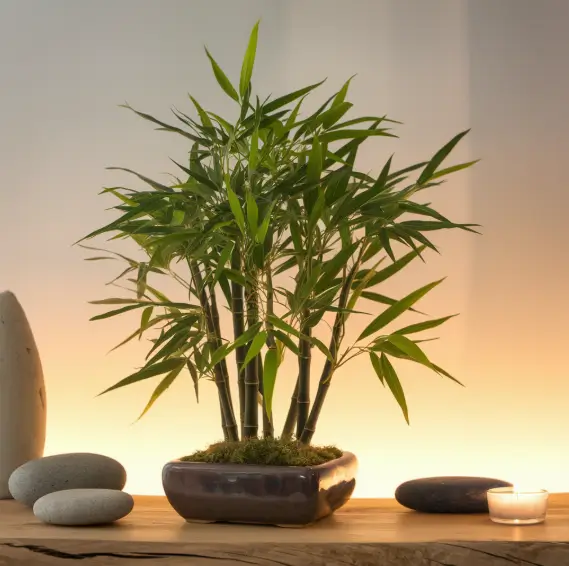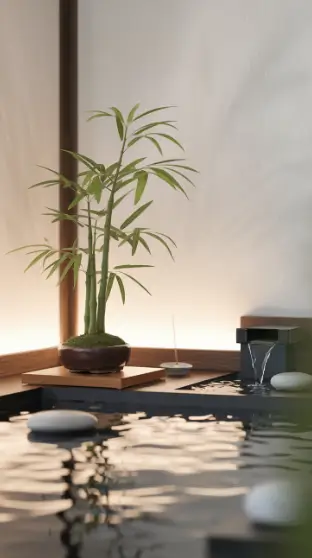Table of Contents
Introduction to Bonsai Bamboo
I still remember the first time I saw a bonsai bamboo plant. It was at my grandmother’s house, sitting gracefully on the windowsill, bathed in the soft morning sunlight. She would carefully water it every day, speaking to it as if it were an old friend. Over the years, I have understood why she cherished it so profoundly. The bonsai bamboo plant is not just an ornamental piece but a symbol of resilience, balance, and tranquility.
In this guide, I will walk you through everything you need to know about bonsai bamboo plant care. Whether you are a beginner or an experienced gardener, this comprehensive resource will help you understand how to cultivate, nurture, and enjoy the beauty of bonsai bamboo. From selecting the right species to ensuring proper growth conditions, I will cover every essential aspect in detail.

Selecting the Right Bamboo Species for Bonsai
Clumping vs. Running Bamboo Varieties
- Clumping bamboo grows in a controlled, compact manner, making it more suitable for bonsai cultivation.
- Running bamboo spreads aggressively through underground rhizomes and requires frequent maintenance.
Recommended Species for Bonsai Cultivation
- Bambusa vulgaris: A popular clumping species known for its lush green foliage.
- Phyllostachys aurea (Golden Bamboo): Ideal for bonsai due to its elegant golden stems.
- Dracaena sanderiana (Lucky Bamboo): Although not a true bamboo, it is commonly used in bonsai for its aesthetic appeal.
Optimal Growing Conditions
Light Requirements
- Bamboo bonsai thrives in bright, indirect sunlight.
- Keep the plant protected from intense afternoon sunlight, as it may damage the leaves.
- Place the plant near a south-facing window or use artificial grow lights if growing indoors.
Temperature and Humidity Preferences
- Ideal temperature range: 65-85°F (18-29°C).
- Maintain high humidity levels by misting the leaves or placing a humidity tray under the bonsai pot.
- Keep the plant safe from drastic temperature shifts and strong drafts.
Soil Composition and Potting
Ideal Soil Mix for Bamboo Bonsai
- A soil mix with good drainage is crucial to avoid root rot.
- Recommended mix: 50% organic matter (peat moss, compost) + 25% sand + 25% perlite.
- Keep a slightly acidic to neutral pH level (5.5-7.0).
Choosing the Right Container
- Choose a wide, shallow container to support healthy root development.
- Ensure the pot has adequate drainage holes.
- Use ceramic or clay pots to retain moisture while allowing aeration.
Watering and Fertilization Techniques
Proper Watering Practices
- Provide deep but occasional watering to support strong root development.
- Avoid waterlogging by ensuring excess water drains out.
- Use rainwater or filtered water to prevent chlorine buildup in the soil.
Fertilizer Types and Application Schedules
- Use a balanced liquid fertilizer (10-10-10) monthly during the growing season.
- Reduce fertilization in winter to allow dormancy.
- Supplement with organic compost or fish emulsion for enhanced growth.
Pruning and Shaping Your Bamboo Bonsai
Techniques for Pruning Bamboo
- Regular trimming promotes a compact and aesthetic form.
- Remove dead or yellowing leaves to maintain plant health.
- Prune extended roots to keep the plant from becoming root-bound.

Styling Methods to Achieve Desired Aesthetics
- Use wire training to shape branches carefully.
- Experiment with traditional bonsai styles like formal upright, slanting, or cascading.
- Maintain symmetry and proportion for a balanced appearance.
Common Pests and Diseases
Identifying and Managing Pests
- Common pests: spider mites, aphids, and mealybugs.
- Apply neem oil or insecticidal soap to manage infestations.
- Release beneficial insects, such as ladybugs, to manage pest populations.
Preventing and Treating Common Diseases
- Fungal infections can arise from excessive moisture.
- Improve air circulation around the plant.
- Use a mild fungicide if symptoms persist.
Seasonal Care and Maintenance
Adjusting Care Routines Throughout the Year
- Increase watering frequency in summer due to higher evaporation.
- Reduce watering and fertilization during winter dormancy.
- Monitor for stress signs like leaf yellowing or curling.
Preparing for Dormancy and Active Growth Phases
- Trim and repot in early spring to stimulate new growth.
- Avoid drastic changes in care routines during dormancy.
- Protect outdoor bonsai from frost with insulation materials.
Propagation Methods
Techniques for Propagating Bamboo Bonsai
- Propagation can be done through division, cuttings, or seeds.
- Division method: Separate healthy shoots with roots and replant.
- Cuttings method: Use stem cuttings and place them in water until roots develop.
Tips for Successful Growth from Cuttings
- Keep cuttings in a warm and humid environment.
- Change water regularly to prevent bacterial growth.
- Transplant rooted cuttings into well-draining soil.
Displaying and Enjoying Your Bamboo Bonsai
Creative Display Ideas
- Arrange the bonsai on decorative trays with pebbles and moss.
- Incorporate miniature figurines to create a themed landscape.
- Use wooden stands for an elegant presentation.
Incorporating Bonsai into Interior Décor
- Place bonsai in meditation corners or workspaces.
- Pair with Zen garden elements for a tranquil atmosphere.
- Rotate placement occasionally to ensure even growth.

Frequently Asked Questions
Is Bamboo Bonsai Good Luck?
- Many cultures believe bamboo bonsai brings prosperity and positive energy.
- Feng Shui principles suggest placing it in the wealth corner of the home.
- The number of stalks symbolizes different blessings (e.g., three for happiness, five for health).
What Kills Lucky Bamboo?
- Overwatering or underwatering can stress the plant.
- Exposure to direct sunlight for prolonged periods can cause leaf burn.
- Chemical-laden tap water can lead to toxicity.
How to Keep a Bamboo Plant Healthy?
- Provide consistent care with proper watering, light, and nutrition.
- Maintain cleanliness by removing dust from leaves.
- Re-pot periodically to refresh the soil and prevent root crowding.
What Kind of Soil Do Bonsai Lucky Bamboo Trees Like?
- Well-draining, slightly acidic to neutral soil is ideal.
- A mix of loam, sand, and organic matter works best.
- Avoid compacted soil to ensure root oxygenation.

1 thought on “Bonsai Bamboo Plant Care: A Comprehensive Guide”